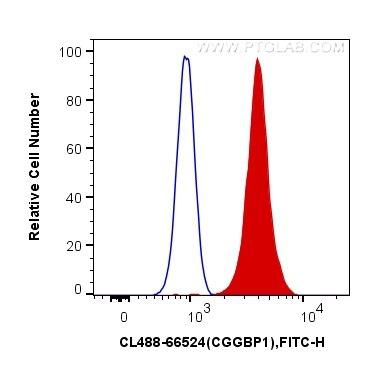Tested Applications
| Positive FC (Intra) detected in | HeLa cells |
| Positive FC detected in | HeLa cells |
Recommended dilution
| Application | Dilution |
|---|---|
| Flow Cytometry (FC) (INTRA) | FC (INTRA) : 0.40 ug per 10^6 cells in a 100 µl suspension |
| Flow Cytometry (FC) | FC : 0.40 ug per 10^6 cells in a 100 µl suspension |
| It is recommended that this reagent should be titrated in each testing system to obtain optimal results. | |
| Sample-dependent, Check data in validation data gallery. | |
Product Information
CL488-66524 targets CGGBP1 in FC (Intra) applications and shows reactivity with Human, Rat, mouse samples.
| Tested Reactivity | Human, Rat, mouse |
| Host / Isotype | Mouse / IgG1 |
| Class | Monoclonal |
| Type | Antibody |
| Immunogen |
CatNo: Ag1129 Product name: Recombinant human CGGBP1 protein Source: e coli.-derived, PGEX-4T Tag: GST Domain: 1-167 aa of BC005222 Sequence: MERFVVTAPPARNRSKTALYVTPLDRVTEFGGELHEDGGKLFCTSCNVVLNHVRKSAISDHLKSKTHTKRKAEFEEQNVRKKQRPLTASLQCNSTAQTEKVSVIQDFVKMCLEANIPLEKADHPAVRAFLSRHVKNGGSIPKSDQLRRTYLPDGYENENQLLNSQDC Predict reactive species |
| Full Name | CGG triplet repeat binding protein 1 |
| Calculated Molecular Weight | 19 kDa |
| Observed Molecular Weight | 19 kDa |
| GenBank Accession Number | BC005222 |
| Gene Symbol | CGGBP1 |
| Gene ID (NCBI) | 8545 |
| RRID | AB_2934474 |
| Conjugate | CoraLite® Plus 488 Fluorescent Dye |
| Excitation/Emission Maxima Wavelengths | 493 nm / 522 nm |
| Form | Liquid |
| Purification Method | Protein G purification |
| UNIPROT ID | Q9UFW8 |
| Storage Buffer | PBS with 50% glycerol, 0.05% Proclin300, 0.5% BSA, pH 7.3. |
| Storage Conditions | Store at -20°C. Avoid exposure to light. Stable for one year after shipment. Aliquoting is unnecessary for -20oC storage. |
Background Information
CGGBP1, also named as CGGBP, is a 20 kDa CGG-binding protein. It binds to nonmethylated 5'-d(CGG)(n)-3' trinucleotide repeats in the FMR1 promoter. CGGBP1 may play a role in regulating FMR1 promoter. It is a bona fide midbody protein required for normal abscission and mitosis in general.(PMID:20832400)
Protocols
| Product Specific Protocols | |
|---|---|
| FC protocol for CL Plus 488 CGGBP1 antibody CL488-66524 | Download protocol |
| Standard Protocols | |
|---|---|
| Click here to view our Standard Protocols |




